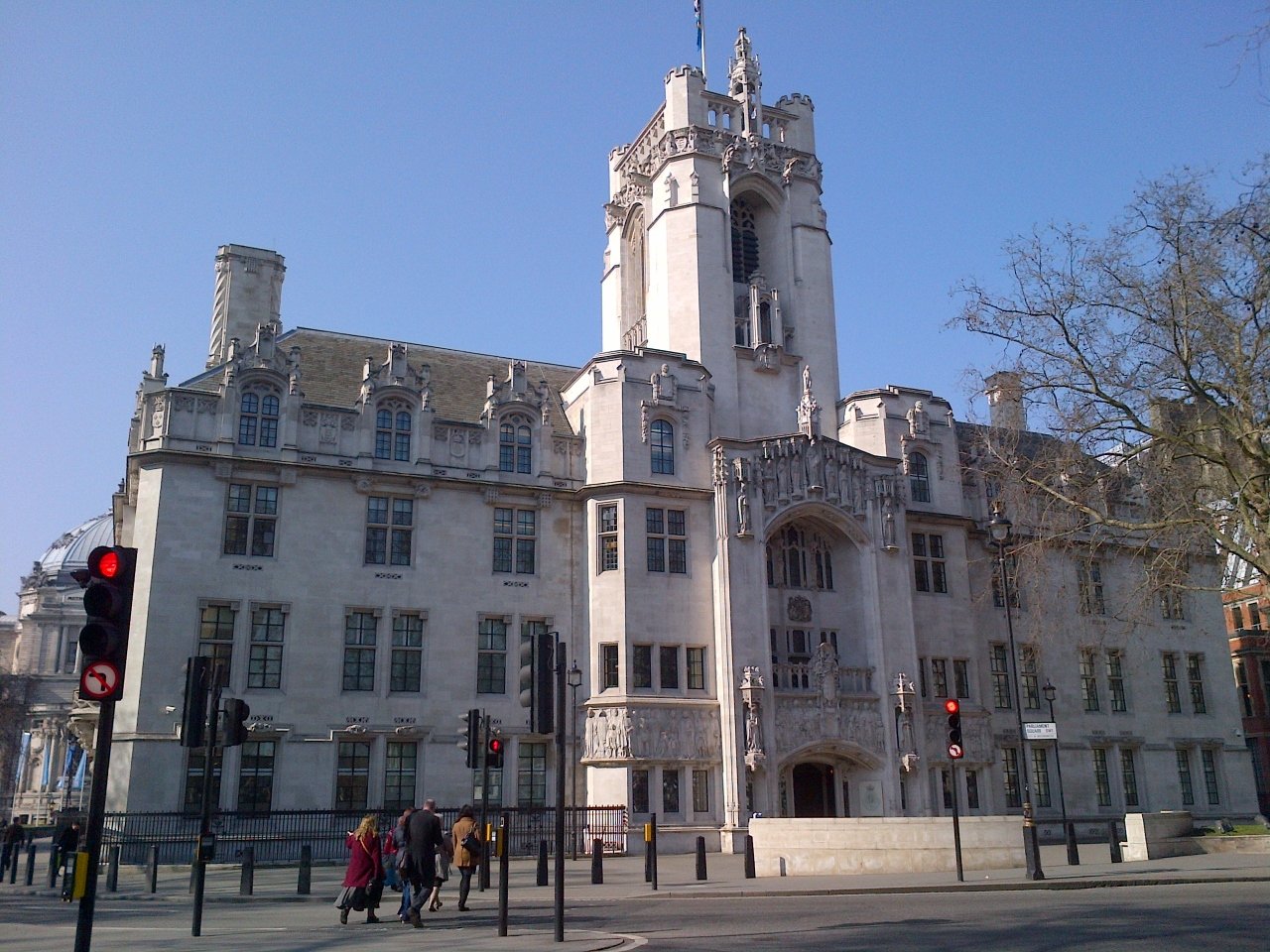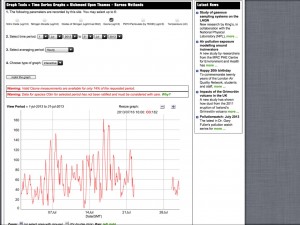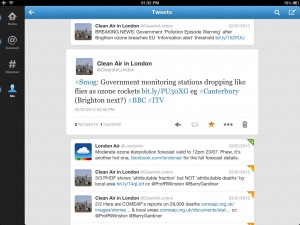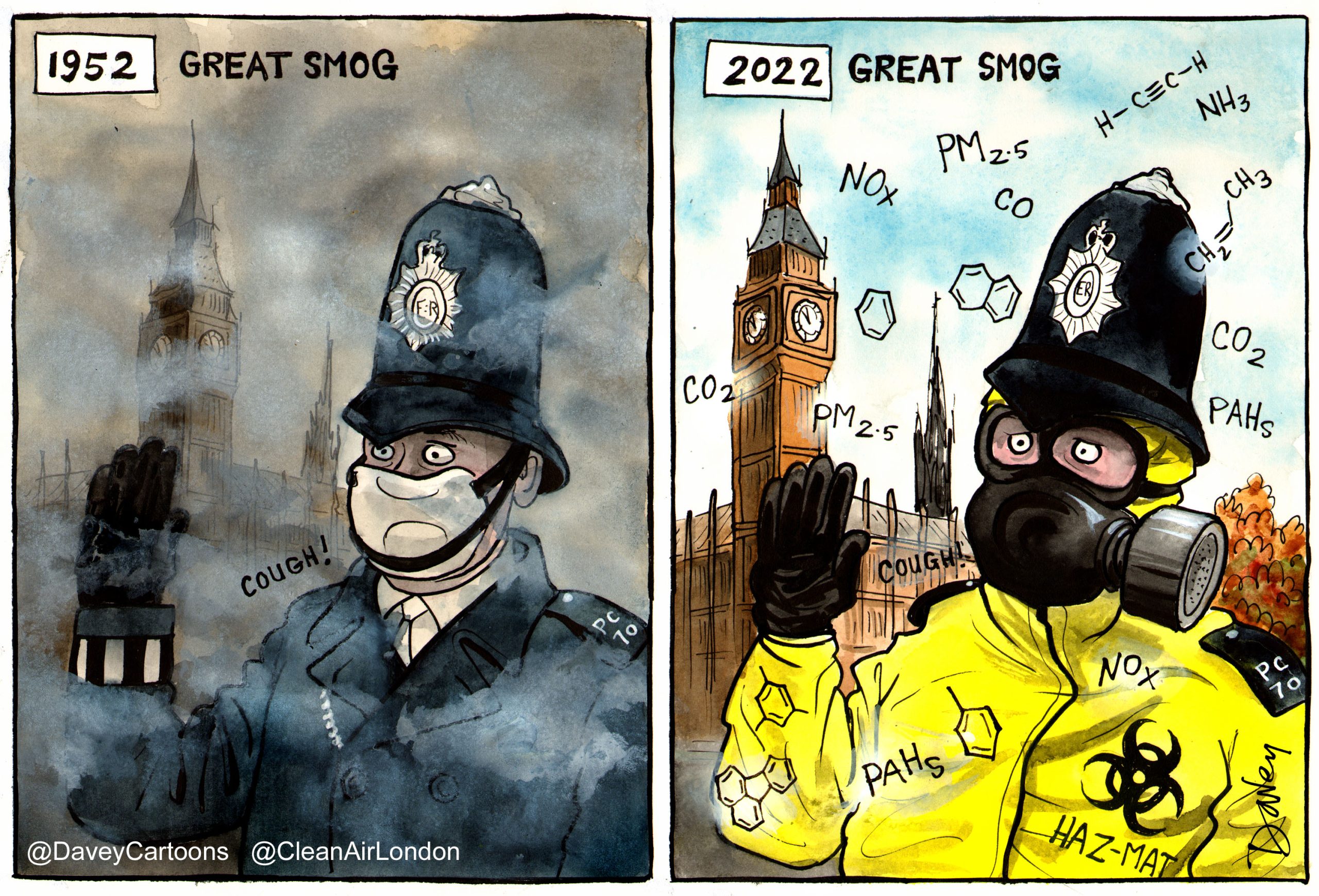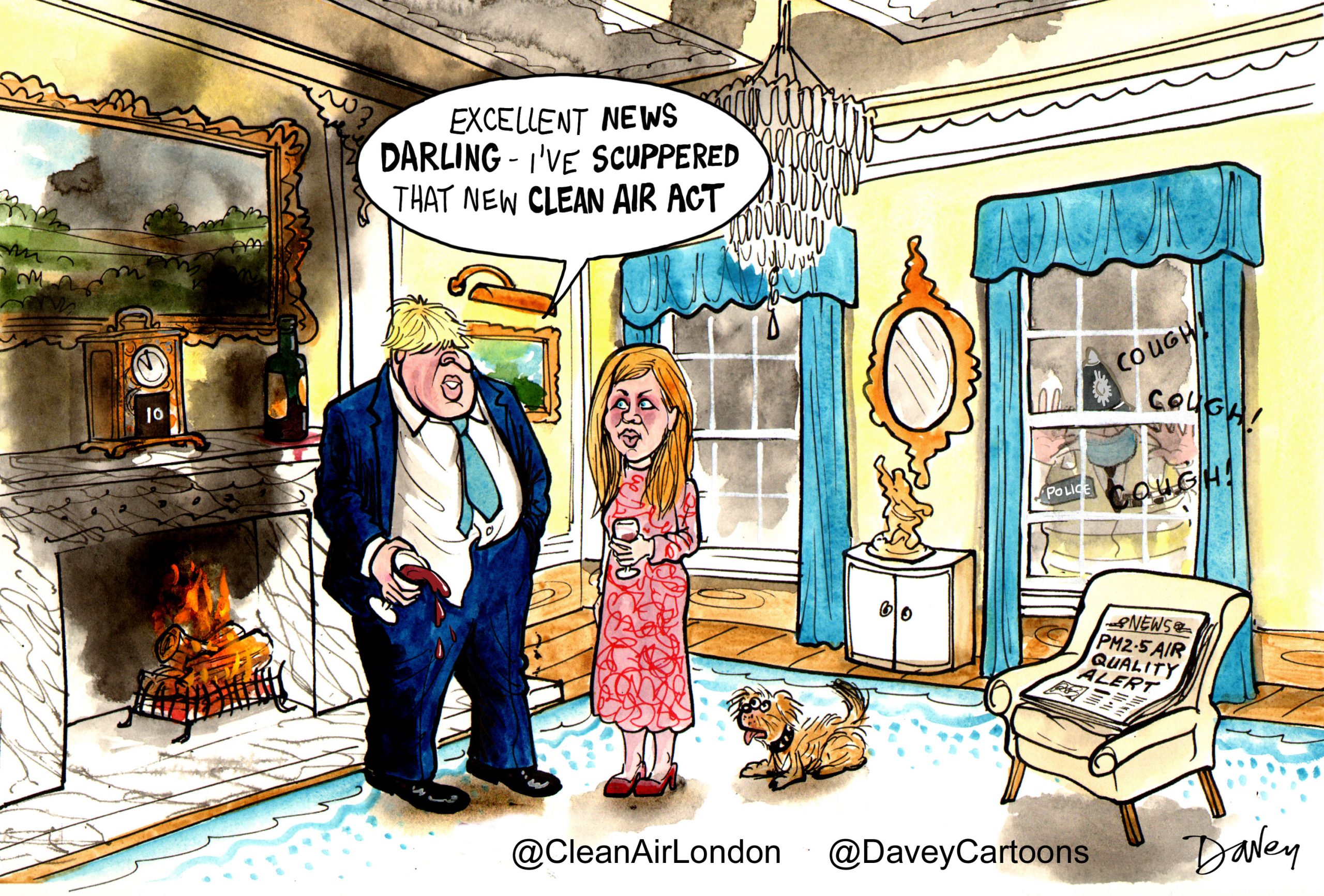Government’s four proposals to scrap or reduce Local Air Quality Management are unacceptable
Government ‘covered-up’ and/or breached its legal duty to issue two separate ‘Information alerts’ to warn the public of smog just days after proposing to scrap local air quality monitoring by others
Lord Berkeley forced Government to disclose UK air pollution (PM2.5) worsened 7.7% in 2011
Government must tighten not loosen obligations to address the biggest public health risk after smoking and reverse the sharp increase in the most dangerous form of air pollution i.e. PM2.5
Dear Secretary of State
By email: [email protected]
I am responding on behalf of Clean Air in London (CAL) to the Department for Environment Food and Rural Affairs’ (Defra’s) consultation on options to ‘improve’ local air quality management in England published on 12 July 2013 which can be seen at:
https://consult.defra.gov.uk/communications/https-consult-defra-gov-uk-laqm_review
In a nutshell, the Government is proposing to reduce or scrap completely the need for monitoring and reporting of air pollution by local authorities. Options 1 and 2 would lead to the demise of continued assessment and reporting at least on objectives that (the Government wrongly alleges) have been met e.g. dangerous airborne particles (PM10). Options 3 or 4 would involve scrapping Air Quality Management Areas (AQMAs) and/or all separate Local Air Quality Management (LAQM) duties. It is not clear whether the Government would even continue to comply with the EU legal requirement to operate its own more limited monitoring network (currently 128 monitors nationally and 300 in total) which can be seen here:
http://uk-air.defra.gov.uk/latest/currentlevels
http://uk-air.defra.gov.uk/interactive-map#network=rm
Despite Government protestations to the contrary CAL considers there is little or no difference in the public health standards implied by individual ‘objectives’ under the Environment Act 1995 (which are enshrined in LAQM duties) and limit values required by Directive 2008/50/EC on ambient air quality and cleaner air in Europe.
Further, the suggestion by the Government that it has the sole prerogative to determine whether or not limit values have been breached is ridiculous. The Government may choose, within the requirements of Directives, what to report to the European Commission and others but it is for the Courts and/or the European Commission not the Government to determine ultimately whether limit values or objectives have been or are being breached. Similarly in respect of ‘data capture’ rates.
‘Cover-up’ and/or breach twice of legal duty to warn the public about serious ‘Summer smog’
Government failed to warn the public about serious ‘Summer smog’ episodes on 16 and 22 July by not issuing an ‘Information alert’ for ozone, the most irritant gas for humans, as required under UK and international law i.e. days after publishing its proposals to scrap or neuter the independent monitoring of air pollution by others.
The UK has only once before needed to issue an ‘Information alert’, required by legislation since 2008, which was for ozone in North Kensington and Charlton Mackrell in the week immediately before the London 2012 Olympics.
As you know, an ‘Information alert’ is required to warn the public when average one-hour ozone levels exceed 180 micrograms per cubic metre (ug/m3). The World Health Organisation (WHO) guideline for human exposure is an eight-hour average of 100 ug/m3. See Directive 2008/50/EC Annex XII on page 32 and the Air Quality Standards Regulations (AQSR 2010) Schedule 5 on page 17:
http://eur-lex.europa.eu/LexUriServ/LexUriServ.do?uri=OJ:L:2008:152:0001:0044:EN:PDF
http://www.legislation.gov.uk/uksi/2010/1001/pdfs/uksi_20101001_en.pdf
The first legal breach occurred when the excellent London Air Quality Network’s (LAQN) monitor in Richmond – Barnes Wetlands recorded average one-hour ozone of 182 ug/m3 at 1600 on Tuesday 16 July. See Exhibit 1:
The second legal breach occurred when the Government’s Automatic Urban and Rural Monitoring Network (AURN) monitor in Canterbury recorded 190 and 194 mg/m3 for ozone at 1400 and 1500 on 22 July 2013 (i.e. the afternoon when Prince George was born) (see Exhibit 2):
http://uk-air.defra.gov.uk/data/data_selector
Astonishingly, after previously finding that Government monitors go ‘offline’ hours before they may report the breach of an ‘Information alert’, CAL tweeted at 4.35 p.m. on 22 July 2013 (Exhibit 3):
#Smog: Government monitoring stations dropping like flies as ozone rockets bit.ly/PU30XG eg #Canterbury (Brighton next?) #BBC #ITV
Minutes later the Government issued an ‘Information alert’ at about 1700 for Brighton after its monitor in Brighton Preston Park recorded average one-hour ozone of 182 mg/m3 at 1600 on 22 July 2013 (Exhibit 4).
Since a smog warning made media headlines in April 2011, the Government has refused to issue a media release warning of smog other than once a year when ozone is expected to reach HIGH on the Government’s own monitoring network i.e. only once, only ozone and only the Government’s limited, unreliable and untrustworthy monitoring network.
Separately, a Parliamentary question from Lord Berkeley forced the Government to disclose on 29 July 2013 that population-weighted levels of annual mean PM2.5 were 13.0 ug/m3 in 2009, 13.0 ug/m3 in 2010 and 14.0 ug/m3 in 2011 triggering a legal requirement to achieve a 15% reduction in such exposure between 2010 and 2020. See:
http://www.theyworkforyou.com/wrans/?id=2013-07-29a.244.6&s=speaker%3A13505#g244.7
In September 2012, the Government had reported 12.5 ug/m3, 13.0 ug/m3 and 13.5 ug/m3 respectively for the same yearswhich meant the average was on the cusp of requiring a 10% or 15% reduction. In other words, the Government has been forced, perhaps by the European Commission, to increase its reported air pollution levels and ensure a 15% reduction in UK population-weighted exposure by 2020.
CAL considers the Government’s monitoring, assessment and reporting of air pollution and issuing of ‘Information alerts’ and smog warnings is limited, unreliable and untrustworthy inter alia for the above reasons.
Consultation response
Key points include:
1. The aims of the consultation of ‘improving and refocusing local air quality management’ are vague and unclear (see paragraph 6 of Executive Summary).
2. It is totally disingenuous of the Government to suggest that local monitoring of air pollution is not a statutory requirement when the duty to ‘assess’ local air quality is such a requirement (section 82(2) of the Environment Act 1995)
http://www.legislation.gov.uk/ukpga/1995/25/section/82
Even Defra’s Impact Assessment for its preferred Option 3 assumes that local monitoring will disappear (pages 9 and 12).
3. The Government’s plans to scrap, following a statutory consultation in 2014, ‘Supplementary (or Further) assessments’ of air pollution are unacceptable if they would result in less transparency or rigour than currently in the local assessment and reporting of air pollution. Such assessments are detailed studies to check a decision is right and take into account any new information.
4. Options 1 and 2 are vague but would remove the need to carry out Further Assessments and could remove the continued assessment and reporting on objectives that have been met (but might not be met in future) or otherwise scrap reviews and assessments. Defra assumes these changes would lead only to reductions in reporting whereas they are likely inevitably also to lead to reductions in assessment and monitoring.
Defra guidance already states:
‘DEFRA and the DAs have no strong views on whether the Further Assessment and the Action Plan should be prepared as individual or combined reports. A combined report (perhaps submitted as the Action Plan with the Further Assessment included in a technical annex) may be a useful format, and would minimise the burden on all consultees.
‘Where a combined report is submitted, then the appraisal process will proceed in 2 distinct steps. Firstly, the ‘Further Assessment’ component will be appraised. The appraisal of the Action Plan is unlikely to take place until the ‘Further Assessment’ conclusions are agreed. This is because the conclusions of the ‘Further Assessment’ report are fundamental to the outcome of the Action Plan.’
http://laqm.defra.gov.uk/laqm-faqs/faq23.html
Further, the inclusion in Option 1 (and therefore Option 2) of ‘Review the need for continued assessment and reporting on objectives that have been met’ looks like a plan by Defra to scrap these requirements for PM10 limit values and/or objectives which the Government wrongly claims have been achieved throughout the UK.
5. The Government’s preferred Option 3 suggests that local authorities will not be required to review and assess air quality. Given the difficult financial situation many local authorities find themselves in, this is likely to result in the closure of a large number of air quality monitoring stations. This will lead to the loss of very valuable data. Local authority monitoring is essential for local accountability, to demonstrate compliance with the health based targets and to provide an assessment of the effectiveness of actions to improve air quality. The data is also used to support public information systems such as the London Air Quality Network and airTEXT.
Page 9 of the Impact Assessment estimates that monitoring by local authorities totalling 117,360 nitrogen dioxide diffusion tube per annum plus 600 sites monitoring for oxides of nitrogen and 200 sites for dangerous airborne particles (PM10) could be scrapped.
6. Option 3 would also remove the requirement to declare Air Quality Management Areas (AQMAs) or retain existing ones. AQMAs are an important tool used by local authorities in a range of policies such as development control and for requiring drivers to turn vehicle engines off when stationary. Rather than being removed, AQMAs should be retained and amended to provide a stronger framework for action. AQMAs would benefit from being similar to Smokeless Zones under the Clean Air Act, which have been very successful in eliminating sulphurous, smoky fuel.
7. Option 4 would go further even than Option 3 to scrap the existing framework and processes.
8. The consultation document is very dismissive of so-called ‘hotspots’ where air pollution is particularly bad. This shows a fundamental lack of understanding within Government of the legal protections in place. Legal limits for air pollution provide a cap everywhere to ensure a minimum standard of protection and require much wider reductions in air pollution for the general population to ensure that limits are not breached also at the worst locations i.e. hotspots.
9. Planning. AQMAs play a vital role in the local planning system. For example, the London Plan’s Policy 7.14 states:
‘Development should:
a. minimise increased exposure to existing poor air quality and make provision to address local problems of air quality (particularly within Air Quality Management Areas (AQMAs) and where development is likely to be used by large numbers of those particularly vulnerable to poor air quality, such as children or older people…
b. …
c. be at least ‘air quality neutral’ and not lead to further deterioration of existing poor air quality (such as areas designated as Air Quality Management Areas (AQMAs).’
Weakening or scrapping AQMAs would drive a coach and horses through protections in the planning system.
In summary, the Government’s proposals would:
- reduce or remove the monitoring and/or reporting of air pollution by local authorities;
- leave the public and others relying on the Government’s limited, unreliable and untrustworthy monitoring network to ‘highlight’ air pollution episodes and its computer modelling to highlight, through some undefined process legal breaches perhaps nine months or more after the calendar year end;
- remove the protections and accountability of the Air Quality Management Area system; and
- drive a coach and horses through fundamental protections in the planning system.
All four of the Government’s proposals are unacceptable.
Way forward
The Government should go back to the drawing board to develop powerful aims and an approach which builds on the strengths of the current local air quality management system not undermines it.
For example, CAL would like to see:
i. the aims of any changes focused on achieving ‘Co-ordinated local, regional and national action to improve air quality to benefit public health and ensure full compliance with legal limits and other obligations’;
ii. the Environment Agency given powers, duties and resources to ensure full compliance with the limit values i.e. similar to the system in the United States and as was proposed by the Labour Government when it approved the third runway at Heathrow. This change should be combined with greater clarity on the roles and responsibilities of local, regional and national Government;
iii. local and regional authorities given stricter duties than the currently feeble requirement to ‘work towards’ the limit values and other air quality requirements. CAL proposed this approach to Defra in a letter dated 26 September 2008:
“For example, CAL considers that the Mayor of London and/or local authorities should each be under a clear statutory duty to implement successfully actions to improve local air quality, when it exceeds limit values, which are meaningful when judged in the context of all their available powers and the deadlines applicable under UK and European law.”
https://cleanair.london/solutions/defra-consultation-on-draft-local-air-quality-management-guidance/
There needs to be a statutory duty on local authorities to identify, assess and act on local air quality problems. The important role for AQMAs in driving improvements through the planning process must be emphasised;
iv. PM2.5 included in LAQM not least to ensure the required 20% reduction in UK population-weighted PM2.5 is achieved by 2020 There should be better alignment generally of UK air quality objectives and EU limit values and other requirements e.g. benzene, 1,3-butadiene, ozone, PM2.5, polycyclic aromatic hydrocarbons and sulphur dioxide; and
v. Health and Wellbeing Boards under a statutory duty to identify through the Joint Strategic Needs Assessments process the biggest local public health risks and then prioritise action on them in their Health and Wellbeing Strategies. Some local authorities are currently acting as ‘busy fools’ prioritising near trivial health issues for action e.g. the lobbying of others.
Please contact me if you would like to discuss this submission.
Yours sincerely
Simon Birkett
Founder and Director
Clean Air in London
CAL 253 LAQN Defra summary sheet of options
CAL 245 Defra letter response redacted and scanned 050913_Reduced file size
CAL 245 Defra response 040913_Annex C_Original
CAL 245 Exhibit 2_Defra AURN data for July 2013

